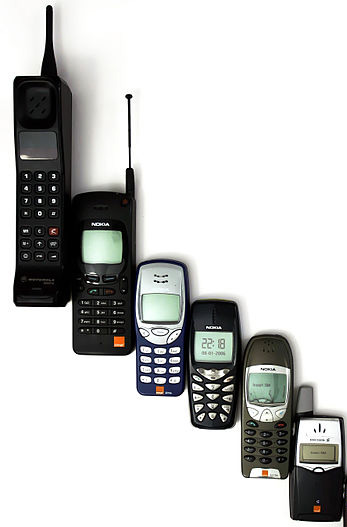Favourite this post in your browser, as I am daring to make predictions on the state of smartphones for next 10 years. Before I do that, I have no qualification or experience in designing or manufacturing or marketing Smartphones, and that is what makes me qualified to do the predictions as an user.
1.By 2020 phones will get smaller & smaller – reversing current trend
When mobile phones were invented in 1973 at Motorola they weighed 2 Kilograms and were bulky. They continued to look more or less the same when they got commercially released after ten years in 1983. In the next 25 years when phone subscribers grew from zero to several billions it was all about how to make the “brick” like phones smaller, lighter and easier to carry. An example was Ericsson’s most loved model T39, introduced in 2001 it weighed just 86 grams. Then iPhone happened in 2007, at 135 grams and 4.5 inches it began reversing the trend of previous 25 years of phones becoming smaller. Today in 2015, iPhone in its latest avatar iPhone 6 Plus weighs 172 grams and 6.22 inches, phones are becoming bigger and bigger. They have blurred the line separating a phone and a tablet.
When iPhone came, following which Samsung continued to introduce larger phones it made sense, as a larger surface area made it easier to use the Touch interface. And users were reading more content in the phones, whether it’s Kindle ebooks or long form (TL;DR) articles or see in retina display the photographs of their loved ones, all of which was happening away from their PCs and Tablets to smartphones since you were carrying one always in your pocket. Smartphones have become the one gadget that you carry with you when you are sitting in restroom stall or when even you are in your bed with your lover.
Now looking forward to next five years, in 2018 I predict Smartphones (or phones from now on) will become smaller and smaller, reversing the trend and going back to basics. Why?
Number One reason I see for this to happen is not due to wearables (I see them as a by product than a cause) but due to evolution of software and change in our usage pattern. For the first time in Human history we are at an inflection point where machines (computers and software) can understand what they see, what we speak and make choices based on them within the parameters of our individual preferences, think of simplest example of Google Now & Apple Siri to Google Cars & XBOX Kinect. In the next five years the capabilities in Artificial Intelligence are going to grow exponentially and have profound impact in the way computers interface with humans, I am talking here of the reverse of Humans communicating to Computers. As you read the last line, you may already be discounting it, but remember as humans we understand incremental growth easily but our brains can’t visualize exponential growth. That’s what is currently happening in Artificial Intelligence powered by Cloud, Big Data & Sensors.
As a result of this, computers need to offer fewer and fewer options and commands to us, they can predict & decide on what we want even before we want it. This means less or zero real estate is needed in a phone to present to us with menus, buttons, textboxes and other GUI elements. What about TL;DR articles and ebooks you may ask, there is a growing trend here that can answer it. With more millennial born growing up along with their short attention spans, the reading habits are fast changing. Majority of the content they consume will be video & audio, the only reading they do will be of extremely shortened summaries crafted personally for them by ubiquitous software. For viewing pictures you will want to use ever larger screens that are to be found in your work place & homes, in the initial years it will continue to be Tablets (iPads) and cheap laptops. For those bibliophiles like me we will use specialized devices like Amazon Kindle in its tenth iteration.
2.By 2025 phones will cease to exist in its current avatar
This one is easier to extrapolate from my previous prediction, it’s just logical progression of phones becoming smaller and smaller, then suddenly disappearing altogether. I don’t mean to say we will not be making calls, reading messages or viewing videos, it’s just that the devices we use for these activities will not be in the form of a phone as we see it today. These capabilities will be part of our everyday objects, invisible individually but all of them are connected to a cloud based neural network like in Avatar’s Pandoran biosphere.
In the technology landscape of 2025, operating systems like Windows, Android or iOS will matter less, web browsers like IE, Chrome & FireFox will cease to exist in their current form, mobile apps would have all transformed to neural nodes. And when all that has happened, remember you read it here at venkatarangan.com in April 2015.
[If you are interested you may read my later post “Technology Landscape in next 5 years” on a similar topic. Thanks]

I take a different view. There are two aspect to a smartphone’s usage – consumption and creation. I use my phone for taking/editing pictures, videos, music and even for writing. All of this has been enabled by computing power on the device, computing power in the cloud, but most importantly by a bigger screen and to some extent multi-touch.
So while consumption patterns could be easily addressed by even wearables that project screens directly onto your retina, I think we are going to find creation a little difficult. We are only beginning to see the kind of software innovation ubiquitous computing power, high resolution screens and multi-touch enable. In the coming 10 years, we will see it play out to its fullest potential.
i.e. I see the next 10 years to be an incremental evolution. The screens won’t grow much bigger, but they’ll increase in resolution, the battery technology will evolve. The speed and bandwidth these devices can use will increase. We’ll see voice input evolve. And we’ll see more and more of humanity’s creative output coming from these devices – whether someone is working alone or with a group of collaborators.
Thanks Deepak for your comment. What you raised are interesting & valid arguments.
I have an answer for content creation, I see it to be a bell curve. We are at the peak of social content created by individuals. I already see brands, marketers & governments taken over Facebook & Twitter. The Arab spring type of twitter empowerment looks ever more distant memory. Individuals will produce petabytes of data every day but they will be generated by software (think IoT) and not by Photoshop, MS Word, iMovies or Eclipse.
Let us wait and watch what happens. I am excited just thinking on the possibilities, and the suspense makes the ride fun.
Well TNC, although what you have mentioned in terms of futuristic devices.. that will essentially happen and you are spot on with that. However what I was saying is just that mindset at one time which was “smaller the phone.. the better” and there was a time where small and slim phones were very expensive, due to their popularity I guess. One I remember was Moto Razr.. and then we went to wider screens with QWERTY keyboards.. then shifted to touch screens where the bigger the screen.. the better it is.. of course given the ease of managing the device.. thats the trend I am refering to.
I agree with what Deepak has commented.. Voice input, battery, bandwidth, resolution are the things where perhaps the competition will be. Wearables will certainly be there but I see them as add ons to phones with around 5 inch screens.